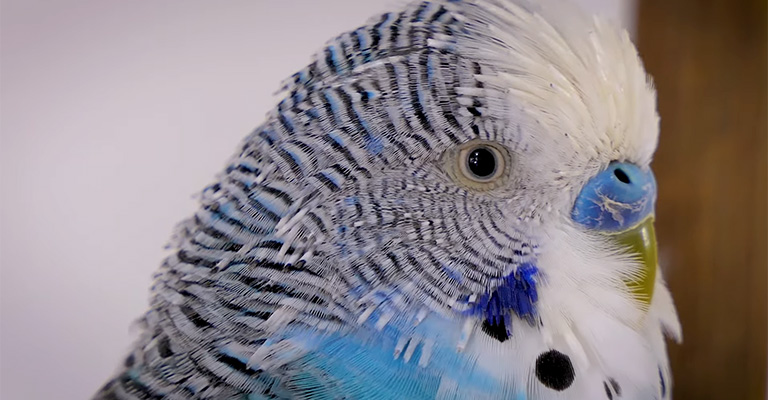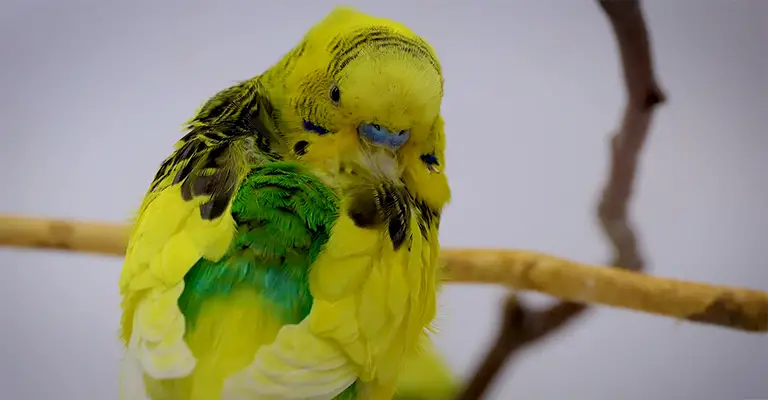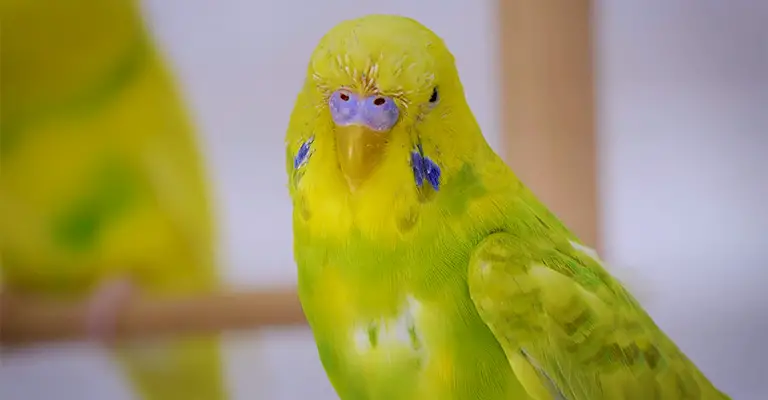The vibrant colors and unique patterns on a budgie’s plumage are not only a source of admiration but also a vital aspect of their identity.
Imagine the surprise when I noticed that my beloved budgie had lost all the distinctive stripes adorning his head, leaving behind a stark and puzzling transformation.
In this intriguing exploration, we delve into the enigmatic phenomenon of why my budgie’s head stripes vanished. These head stripes, known as “head bars,” are a defining feature.
When these stripes begin to disappear, it raises questions about health, behavior, and genetics. So, why did my budgie lose all his stripes from his head?
Join me on this journey as we unravel the possible explanations behind this intriguing transformation, delving into the fascinating world of budgie plumage and what it might reveal about the well-being of our feathered companions.

Why My Budgie Lose All His Stripes from His Head?
The loss of head stripes in budgies can occur for several reasons. From molting to genetics, the reasons are widespread.
It’s essential to consider that each budgie is unique, and there could be other individual factors at play. Here are the details:
Molt
One common reason is molting, a natural process where budgies shed old feathers and grow new ones. During molting, the head stripes may temporarily disappear, but they usually return once the new feathers grow in.
Aging
As budgies age, their feather patterns can change. Some budgies naturally lose their head stripes as they mature, and this is not a cause for concern.
Dietary Factors
Poor nutrition can affect a budgie’s feather quality and coloration. Ensure your budgie has a balanced diet rich in vitamins and minerals, as nutritional deficiencies can impact their feathers.
Stress or Illness
High levels of stress or underlying health issues can affect a budgie’s feather condition. If your budgie is experiencing stress or illness, it might lead to changes in their plumage.
Genetics
In some cases, genetics play a role. Certain budgie mutations can result in altered feather patterns. If your budgie has specific genetic traits, it might explain the absence of head stripes.
Injury
If your budgie experiences an injury or is engaging in feather-plucking behavior, it could lead to the loss of head stripes in the affected area.
Infection or Parasites
Certain infections or parasites, such as mites, can affect a budgie’s feathers, leading to feather loss or changes in feather appearance.
Environmental Factors
Changes in the environment, such as exposure to excessive heat or chemicals, could impact feather health.
Skin Conditions
Rare skin conditions can affect feather growth and appearance. An avian veterinarian can diagnose such conditions through a thorough examination.
If you’re concerned about your budgie’s feather loss, it’s a good idea to consult an avian veterinarian. They can examine your bird, rule out any health issues, and provide guidance on proper care and nutrition to ensure your budgie’s feathers return to their normal state.
How to Prevent Budgie Losing His Stripes from Head?

Preventing your budgie from losing the stripes on its head largely depends on maintaining good overall health and ensuring proper care.
While some factors, like molting and aging, are natural and may cause temporary changes in plumage, you can take steps to support your budgie’s feather health and pattern. Here’s how:
Balanced Diet
Provide a well-balanced diet rich in nutrients. Commercial budgie seed mixes or pellets are a good foundation, supplemented with fresh fruits and vegetables. Ensuring proper nutrition can promote healthy feathers.
Clean Environment
Keep your budgie’s cage clean and hygienic. Regularly clean perches, food and water dishes, and the cage itself to prevent the buildup of dirt and bacteria, which can affect feather health.
Regular Vet Check-Ups
Schedule regular check-ups with an avian veterinarian. They can monitor your budgie’s health and address any issues before they become severe.
Stress Reduction
Minimize stress in your budgie’s environment. Avoid loud noises, sudden temperature fluctuations, and changes in routine. Provide a safe and secure cage.
Social Interaction
Budgies are social birds. Interact with your budgie daily to reduce loneliness and stress. Consider getting a companion budgie if it’s appropriate for your circumstances.
Supervision During Playtime
When you allow your budgie out of its cage for playtime, ensure that the area is bird-proofed and free of potential hazards.
Keep your budgie away from anything toxic, including fumes from cleaning products, non-stick cookware, and certain plants.
Provide Mental Stimulation
Offer toys, puzzles, and activities that stimulate your budgie mentally and physically to prevent boredom and stress.
Ensure your budgie receives natural daylight or use full-spectrum lighting to promote healthy feather growth.
Consult a Vet
If you notice any unusual changes in your budgie’s plumage or health, consult your avian veterinarian promptly to rule out underlying issues.
Remember that while you can take steps to maintain your budgie’s overall health and feather quality, natural changes like molting and aging may still result in temporary alterations to its head stripes. Regular monitoring and attentive care are essential to keeping your budgie happy and healthy.
How Do I Know If My Budgie Is Molting?

Molting is a natural process in which budgies (parakeets) shed old feathers and grow new ones. It’s a crucial part of their life cycle and typically occurs multiple times throughout a budgie’s life. Here’s an overview of the budgie molting process:
Initiation
Molting can be triggered by various factors, including changes in daylight hours, temperature, and hormonal shifts. It’s a sign that your budgie is entering a new phase of growth.
Age
The first molt typically occurs when a budgie is around 3 to 4 months old. During this juvenile molt, they replace their baby feathers with their adult plumage. It’s also when you might see the distinctive head stripes and other adult feather patterns develop.
Feather Loss
During molting, budgies will lose feathers gradually, usually starting from their head and progressing down the body. They may appear scruffy as old feathers become loose and fall out.
New Feather Growth
As old feathers are shed, new feathers start to grow in their place. The growth of new feathers is called “pinfeathers” or “blood feathers” because they initially have a shaft filled with blood vessels. These gradually harden and develop into the colorful feathers characteristic of budgies.
Duration
Molting can vary in duration, but it typically takes a few weeks to a few months, depending on the extent of feather replacement. Some budgies undergo a full molt, where nearly all feathers are replaced, while others may only molt a few feathers at a time.
Behavioral Changes
During molting, budgies might exhibit some changes in behavior. They can be a bit more irritable or sensitive due to the discomfort associated with growing new feathers. Providing extra care, such as gentle handling and maintaining a stable environment, can help them through this period.
Nutrition
It’s crucial to ensure that your budgie receives a balanced diet during molting. Adequate protein and nutrients are needed to support the growth of new feathers. Consider supplementing their diet with fresh fruits and vegetables.
Hydration
Proper hydration is essential, so make sure your budgie has access to fresh, clean water at all times.
Avoid Stress
Try to minimize stress during molting, as this can make the process more comfortable for your budgie. Keep their environment calm and consistent.
Annual Molt
After the juvenile molt, budgies usually go through an annual molt, typically occurring once a year. This molt can happen at any time of the year and helps them maintain the quality and condition of their feathers. The timing may be influenced by factors like daylight hours and temperature.
Post-Molt Appearance
Once the molting process is complete, your budgie will have a fresh set of feathers that are vibrant in color and condition.
Molting is a natural and necessary part of a budgie’s life, and it’s essential to provide them with the care and support they need during this period.
If you notice any signs of abnormal or excessive feather loss or if your budgie seems unwell during molting, consult with an avian veterinarian for guidance and reassurance.
FAQs
Yes, it’s normal for budgies to lose their head stripes during molting. Molting is a natural process where old feathers are shed and replaced with new ones, and the head stripes often return once molting is complete.
The timing can vary, but it usually takes a few weeks to a few months for a budgie’s head stripes to grow back after molting, depending on the individual bird and the extent of the molt.
While molting and aging are common reasons for losing head stripes, underlying health issues, such as poor nutrition or stress, could affect feather health. Consult a vet if you suspect health problems.
If the head stripes do not return after molting or if you notice other unusual feather changes, it’s a good idea to consult an avian veterinarian to rule out any underlying health issues.
Ensuring a balanced diet, maintaining a stress-free environment, and providing proper nutrition can support overall feather health in budgies. However, the presence or absence of head stripes is mainly influenced by genetics and molting.
Conclusion
The mystery behind my budgie losing all his head stripes proved to be a captivating journey filled with insights into the complex world of avian health and behavior.
Throughout this exploration, I’ve come to appreciate the remarkable adaptability and resilience of budgies.
Their ever-changing plumage and unique responses to their environment continue to remind us of the intricate connection between nature and nurture in the avian world.
This experience has underscored the importance of attentive and caring pet ownership.
Regular check-ups with an avian veterinarian and a balanced diet, a safe and stimulating environment, and plenty of social interaction are key to ensuring the well-being of our feathered friends.
As my budgie continues to thrive despite the disappearance of his head stripes, it serves as a testament to the beauty and mystery of the natural world, and the enduring bond we share with our cherished avian companions.